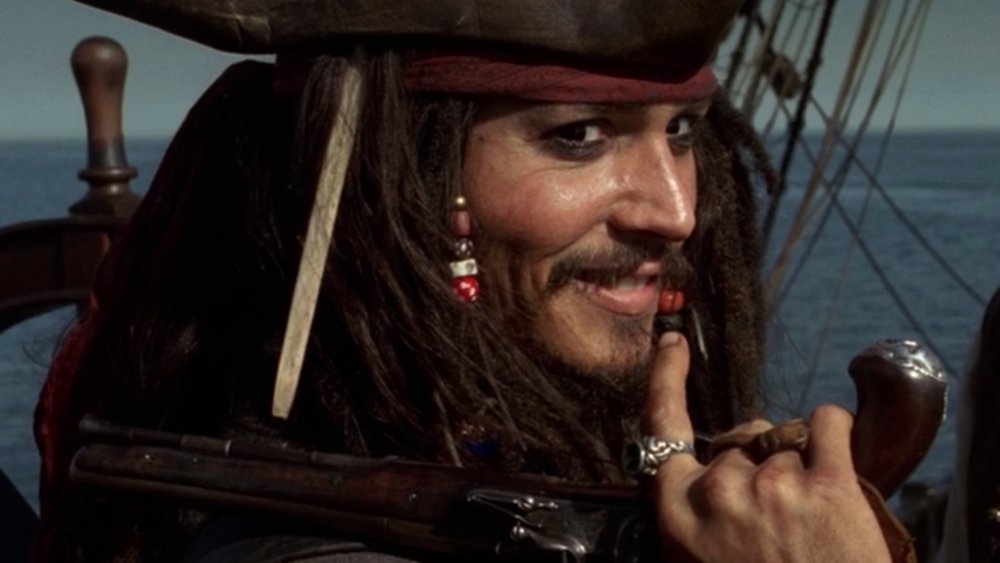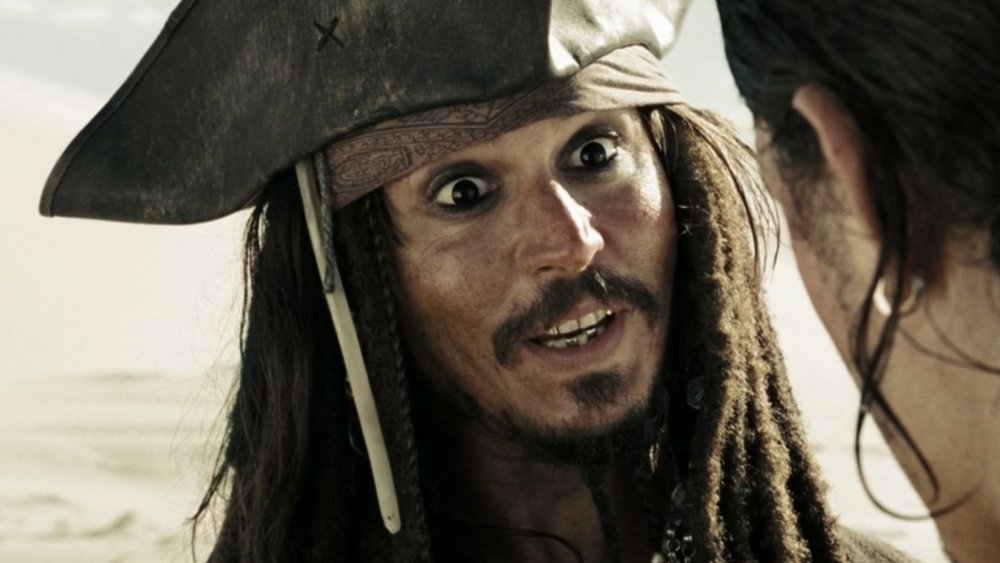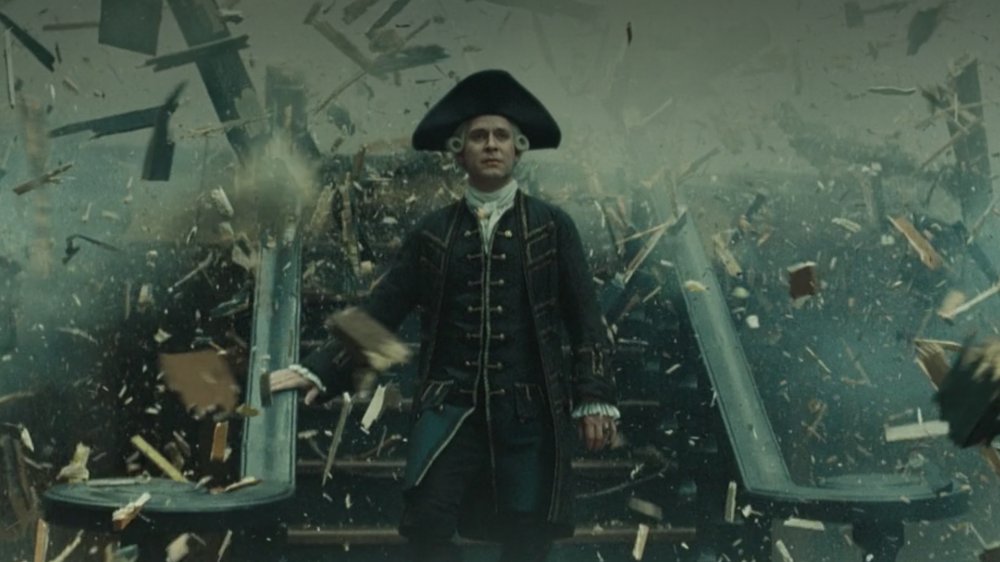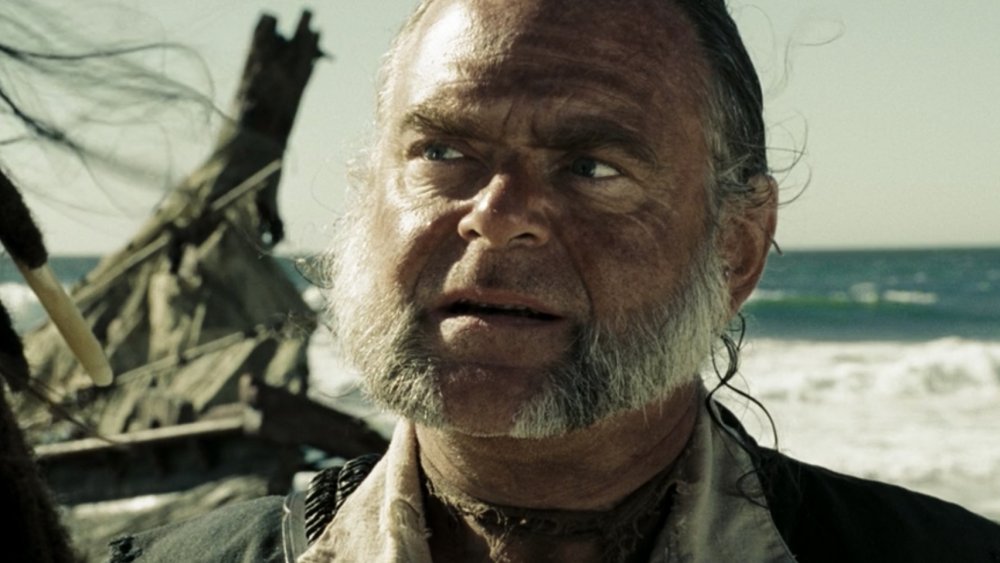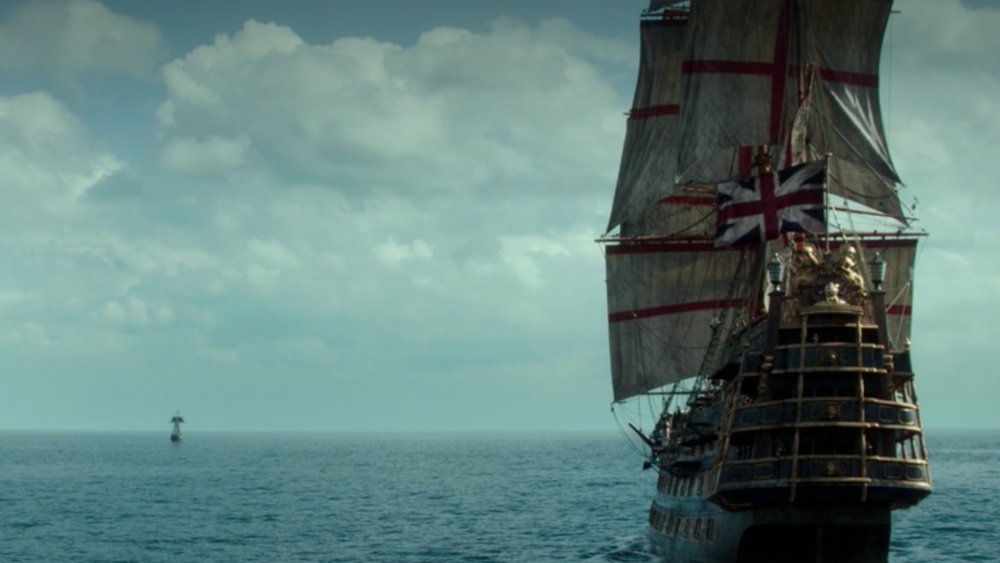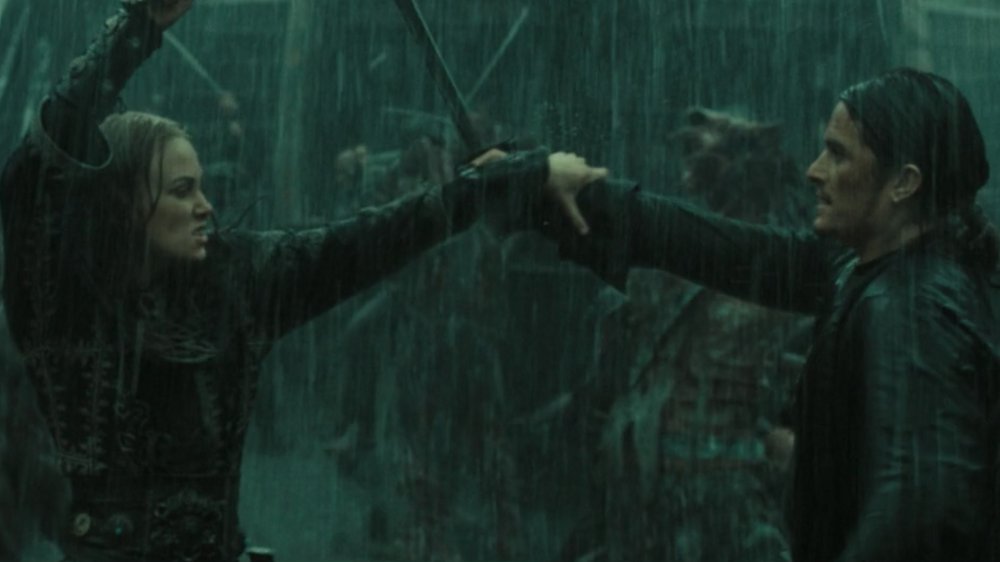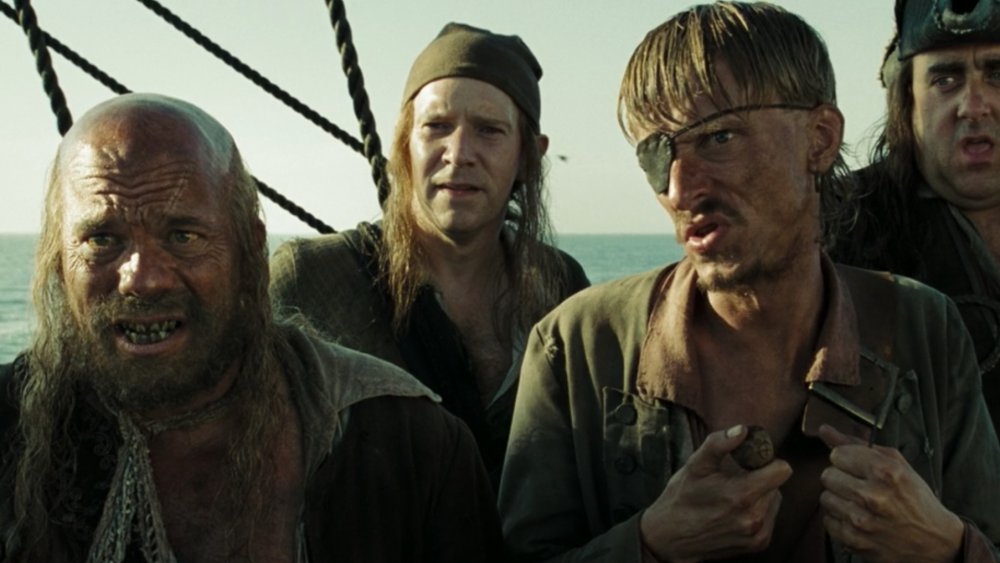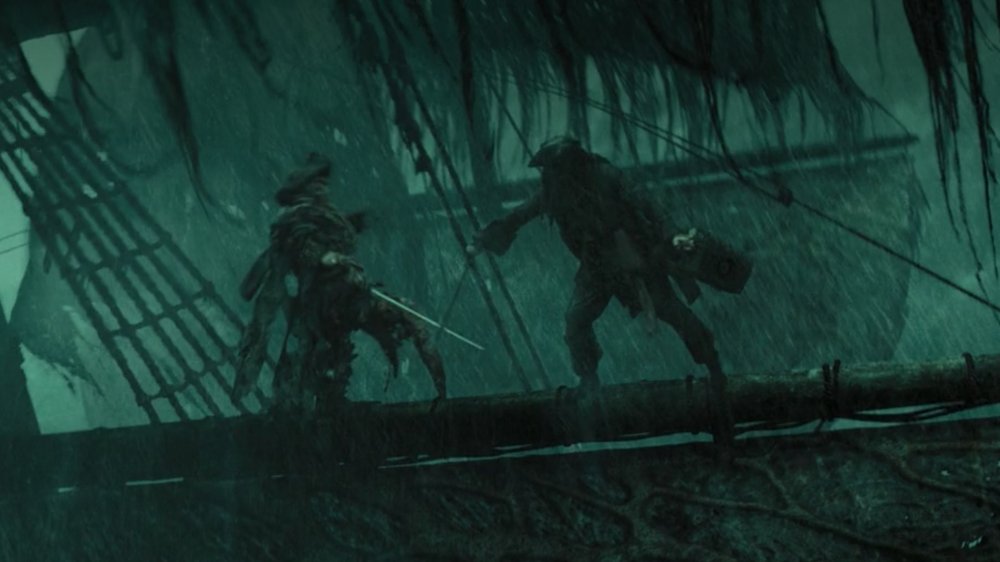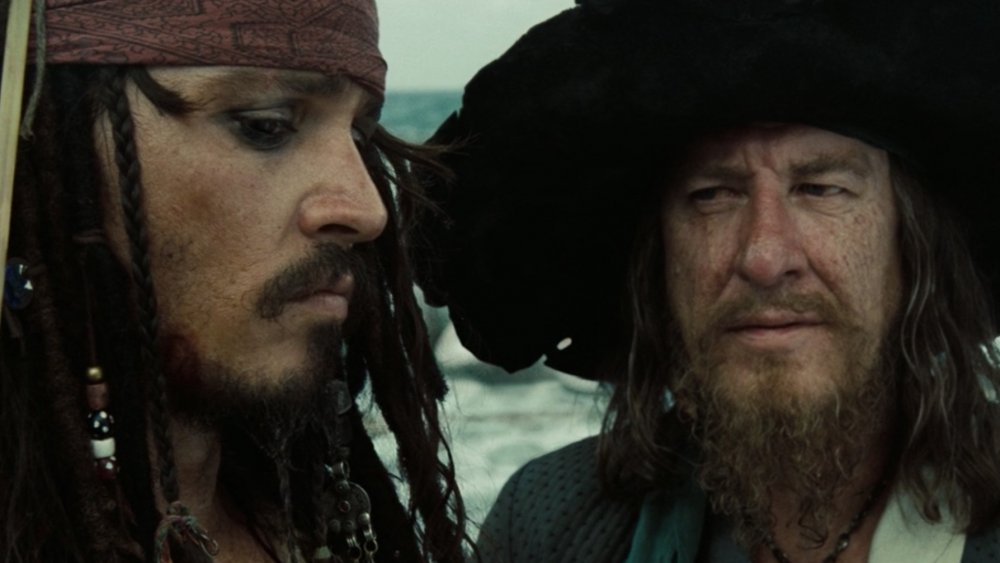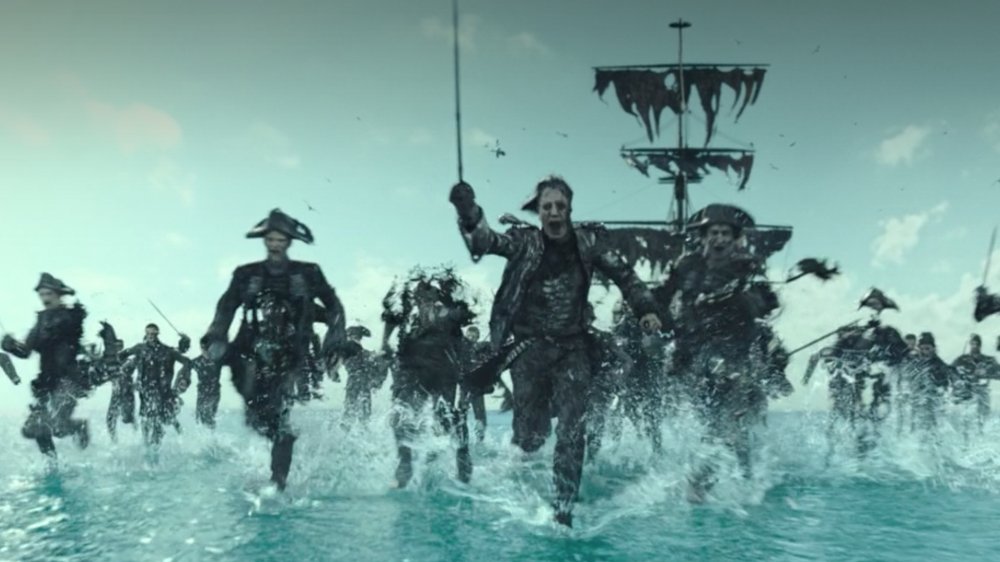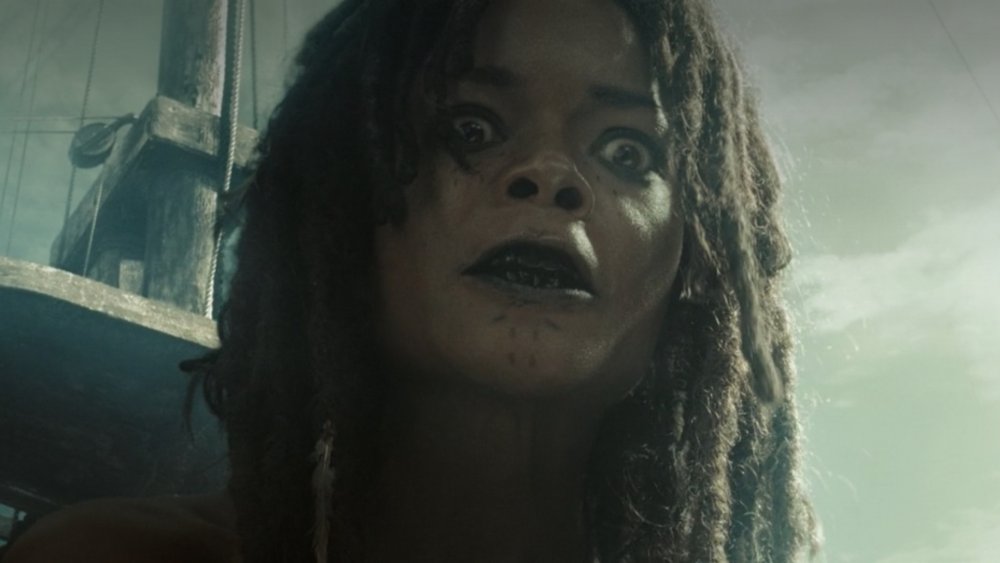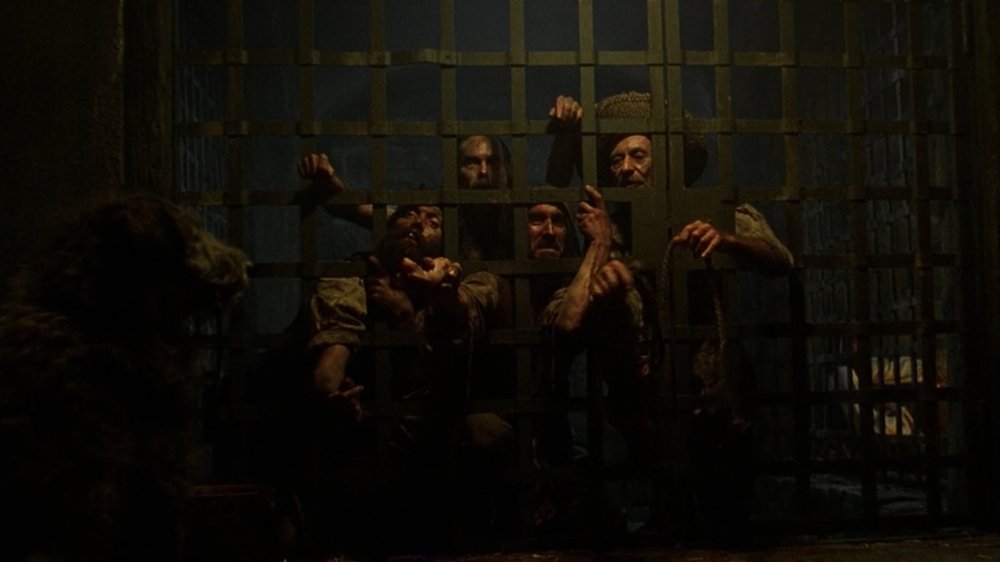Things Only Adults Notice In The Pirates Of The Caribbean Movies
The allure of shiny baubles and trinkets has been a staple of human desire since back when we threw virgins into volcanoes. Combine this desire with the joy we feel in solving riddles, and you get a treasure map leading you straight to a successful genre. Pirates have been woven into our culture, and the cream of the swashbuckling crop is the delicious franchise led by one Captain Jack Sparrow (Johnny Depp). Pirates of the Caribbean has sailed across the box office seas five times to rake in over $4.5 billion in booty worldwide. A sixth installment is in the works, with Depp reportedly returning to his iconic role.
The first film in the series (Pirates of the Caribbean: The Curse of The Black Pearl) was released in 2003. It elevated Johnny Depp from renowned character actor to household name. All five films have received a PG-13 rating but are considered by most to be a family viewing experience. Unless your toddler will get night terrors from sea monsters or gingivitis, you're probably good to gather the kiddos together for a viewing session. The first film was Disney's attempt to balance out its childish reputation and appeal to teenage and adult sensibilities as well — which proved a massively successful endeavor. Adults and children will have a very different viewing experience when sitting down to watch Pirates of the Caribbean films, though. Kids will be giddy about the pursuit of treasure and sword fights, while there are a lot of other elements that only adults will notice.
Jack Sparrow is a terrible captain
A ship without a captain is but a mindless pile of driftwood. The vessel needs guidance, especially for its daft crew members, who can easily succumb to superstition and scurvy. The most notable captain in the Pirates of the Caribbean series is the one and only Captain Jack Sparrow. Johnny Depp brought the character to life, putting an acting savvy on display that carried the series through five films. His comedic acting is one for the ages — it entertained the kids, made the adults feel like kids, and reminded everyone that Keith Richards is still alive and still melting. That being said, by the fifth film in the franchise, adults will begin to ask themselves why any of the other pirates blindly follow Jack — besides the promise of immortality, of course.
Pirates are a superstitious bunch, so it makes sense that Jack would be able to prey on their childish minds with his manipulative powers. That's his only real power as a leader: his ability to spin his self-serving aspirations into a palatable mission statement for everyone on board. Beyond that, he runs away from confrontation and throws his friends to the wolves, and his only sense of direction comes from a compass that usually points to the rum bottle. On rare occasions, we see him do the right thing, which creates an intriguing sense of ambiguity to the anti-hero. However, Jack usually gets royally screwed after making the right choices — most notably ending up in the belly of a Kraken. What a wonderful lesson for the kids.
The ships can take a lot of cannonball hits
The Pirates franchise starts off in what is apparently colonial times ... or is it medieval times? It's all based in a fantasy land where you can sail off the edge of the world into a land of the dead, so the when of it all isn't too crucial. Whenever it is, they still make ships out of wood, and water operates the same as it does in our reality — unless there's a ship carrying a primary character during a naval battle. Then the wood will regenerate, or water will wash innocently over shredded hulls, refusing to follow the laws of physics. It's unlikely that kids are thinking about ship engineering and structural integrity in the middle of climactic battle sequences. Meanwhile, adults are wondering why the heck these wooden death traps won't sink into the depths.
We watch numerous times as ships pummel each other with a barrage of cast-iron projectiles, ripping holes from port to starboard. Despite their hulls being transformed into swiss cheese, the ships still manage to sail away from battles. They only ever take on enough water to force a bit of a high step while below deck, unless it's a ship whose demise is meant to establish a sense of dread, in which case they plunge into the sea within a matter of seconds. A healthy dose of whimsy is applied to the Pirates of the Caribbean world, but one thing that's never addressed is what master craftsman is assembling these invincible ships capable of multiple battles at sea.
Pirate beards are very well-maintained
Twirling beards and tight dreads are a necessary aesthetic for the raiders featured in the Pirates franchise. The merchants in Tortuga must receive regular shipments of Dapper Dan pomade so that pirates can trade gold doubloons for the tools necessary to maintain their sex appeal at sea. That is the only explanation as to how the mustachioed treasure seekers keep their facial hair in check despite how long they meander through the open sea.
Jack Sparrow's mustache always remains at the perfect length — flirting with unkempt but not out of control. Even his usual first mate, Mister Gibbs (Kevin McNally), sports some nicely manicured mutton chops for a majority of the journey. It actually looks like Gibbs takes plenty of time to run a comb through those gnarly roots while at sea. There's nothing wrong with giving your face some TLC. It's just interesting that these opponents of social decorum would be so apt to maintain visually pleasing face threads. Not that any adult viewers are complaining — at least the pirates are teaching the kids something about self-maintenance. Now if we could just get them to take a bath.
How do all these ships find each other so easily at sea?
The shortest distance between two points is a straight line. Or at least that's what fundamental physics lessons have taught us. Those lessons mentioned nothing about inverting your ship at the moment of the green flash to cross into another plane of reality, but the fundamentals are still there. When sailing in the open sea, you are able to travel directly to your destination — powerful squalls permitting. But ... so is everyone else with a ship. How is it that, among the vastness of the ocean, all the ships are able to track each other down so efficiently?
On multiple occasions, a ship will set off in pursuit of another, sometimes days after their target has left. Lagging departure is of no consequence, because they catch up with them in no time and are able to find them out in the open ocean. The mind of a kid will see sound logic: "They are going where they are going, so of course they will see each other." Any adult with any inkling as to how vast the world is — and how much of that is ocean — may have some qualms as to the validity of pirate ship tracking.
Any adult will recognize that Elizabeth and Will's relationship is unhealthy
Alas, what is a great Disney epic without a tale of love woven into the fantasy? These heartstrings are pulled with a never-ending sense of melancholy by Elizabeth Swann and Will Turner (Keira Knightly and Orlando Bloom). The first film left us with a cute love story which jumped into a wedding at the start of Dead Man's Chest. Shortly after those developments, though, this relationship unraveled. Adults will be quicker to see the cracks and remember that these two have hardly had any time together. They don't really know each other.
Throughout the second and third film, the couple's communication is nonexistent. They refuse to tell each other anything about their feelings whatsoever. Every omission of truth angers the other in a vicious cycle that teeters on toxic. In the third installment (At World's End), Will looks at Elizabeth and says, "If you make your decisions alone, how can I trust you?" Which is an absurdly counter-intuitive statement. Trusting a loved one, by definition, means trusting the decisions they make. The two make a terrible couple for over four hours of Pirates films before they randomly decide to get married in the middle of a massive battle in an oceanic hurricane, swirling around a gaping vortex (a perfect visual representation of the relationship itself). Kids see two pretty people who just need to hug it out. Adults see two people who don't belong together trying to force a square block into a round hole.
No one shares plans with anyone else
By the time we get to the third film (At World's End), most of the characters on the screen are essential and have their own machinations at play. Some have plans that reach far out into the future, like Will or Barbossa (Geoffrey Rush). Others' plans stretch as far as grabbing a chest in a moment of opportunity and running into the jungle — i.e. Pintel and his wooden-eyed pal, Ragetti (Lee Arenberg and Mackenzie Crook). In order for the more complex plans to come together, there are numerous moving parts that need to work in order for the desired outcome. Kids derive joy out of watching a miraculous set of circumstances come together and form a positive outcome. Adults will be a bit more perturbed by it all.
It's astounding that anything ever works out, given that no one ever makes a peep as to what's at play. If a single person around them didn't do what they thought they would, everything would crash down in spectacular fashion. A simple solution to ensure success would be to inform all the elements in play. Nope, not for a pirate — hope for the best and proudly accept the glory when you accidentally succeed in a plan that existed nowhere but in your own mind. Take notes, kids.
You can sword fight anywhere
Boxers and wrestlers have the ring. Mixed Martial Arts has the octagon. Sword fighters have the entire world as their arena, apparently. Pirates are renowned sword fighters and are well-aware that a clashing of steel can occur anywhere at any time. Who's to know if the swashbucklers of the past had a preferred arena when engaging in a tango of the blade, but in the world of Pirates of The Caribbean, even the ceiling rafters serve as a proper stage for a battle. The exhilarating soundtrack and audible clanging of swords is enough to enrapture the younger audiences. Meanwhile, adults begin to feel incredulous by the time a sword fight breaks out on a giant rolling wheel in the jungle.
Much of the time when characters are balancing on beams while slicing and dicing, adults find themselves asking, "Wait, aren't these guys drunk?" We know Pirates has a lot of fantasy elements, but we're pretty sure rum still has the same effects in their world. When compared to the formality of fencing, the contrast actually makes a bit of sense. Aristocratic sword battles entail a posh atmosphere, complete with dorky outfits and flat ground. Meanwhile, the rascals of the sea know that true sword aficionados can battle anywhere — even balancing on a sail mast in a hurricane. Pirates of the Caribbean stretches credulity for adults with sword fight placements, but take a cue from the kids and remember that Jack Sparrow is a legend.
Are there no infections in this world?
If the Pirates of the Caribbean franchise began to get a bit too mystical for you, remember, it started with a crew of pirates cursed to be undead skeletons whose ghastly forms show in the moonlight. By the end of the third film, Jack is rescued from the upside-down, Calypso dissolves into a cascade of crabs, and Will gains the "curse" of immortality by stabbing the beating heart of Davy Jones. The next two installments continued down the same whimsical path. The human petri dishes we call children may not have noticed by this point, but adults notice the fact that infections or disease are nonexistent.
Especially when you consider that every character in the movie is wet 80 percent of the time, it's an interesting fact that no one's wounds ever fester. In one film, Jack sports an open chunk of skin on his chin for a large amount of time. It looks as though he douses it with peroxide in between each take. The lack of infected wounds is surprising, given that everyone appears as though they bathe with rainwater and spend a majority of their lives covered in mud. No matter the circumstances — whether it be sleeping in a pig latrine or wading through a swamp — everyone comes out the other side disease-free. What a magical time to be alive. No need for hand sanitizer in the Pirates of the Caribbean world.
Why are people who are "cursed" blessed with superpowers?
A staple of a curse has always existed in an embodiment of the word itself. Inflicting someone with bad luck or some other hindrance to their ability to live life is a necessity with any curse. Kids watching will easily catch on to the visual representations of said curses: The guy onscreen looks scary and speaks in a creepy voice — ipso facto, that's a cursed bad guy. Any adult who has flipped the bird to social etiquette and trudged through the ice cream aisle in sweatpants knows a thing or two about judging a book by its cover, though.
Kids see a scary bad guy. Adults see a being blessed with immortality and the ability to walk through walls. Why is it that when people are cursed in Pirates of the Caribbean, it comes along with a hearty dose of superpowers? Doesn't really seem too dreadful of an eternal existence when you can sprint across the surface of the ocean. Sure, you can't taste donuts or feel rum tickle your brain stem, but everything comes at a price. Even then, it's pretty easy to maintain a svelte frame through the centuries when sugar doesn't bring you joy.
How the heck did a bunch of broke pirates capture an ethereal sea goddess?
For the finale, you need something big: something gigantic and god-like. The ending moments of the third film featured the pirates releasing the goddess Calypso. Apparently, pirates of yore gathered some trinkets together and used them to bind the goddess into an earthly form — thus taming the seas. The fabled pirates were so poor that they had to use whatever random stuff they had lying around to cast the spell. (The junk was referred to as "the nine pieces of eight.") So, in order to release Calypso at a later time, they had to assemble all those pieces, toss them in a hat, and light them on fire while whispering an incantation. That may be enough to satiate any child's curiosity, but adults will be wanting to know more.
Once Calypso is unleashed, she morphs into a wave of crabs, assumes her celestial form, and takes command of the ocean. That means the Calypso we see creating oceanic maelstroms is the Calypso the pirates in the stories faced. How in the heck did a bunch of pirates — who were so poor they had to use junk drawer contents as their trinkets — capture a goddess? It's a question that will drive adults bonkers. Sure, Davy Jones betrayed her and told the pirates how to bind her, but it seems unlikely that you can just lasso someone with that kind of power. It's a chunk of the fantasy that is glossed over and makes us think ... prequel?
How the heck did they get all this nightmare fuel out of a gentle Disney theme park ride?
Anyone who has been to the Disney amusement parks knows that visiting the Pirates of the Caribbean ride is an essential part of the experience. At Disneyland, it starts with a gentle glide through a bayou with fireflies and then a gentle dip into the lower tier to sail through the story. Most of the ride is a slow trip through an animatronic song and light show. It features cannonball fights, drunk pirates balancing on barrels, parrots, and all sorts of mischievous behavior. The kids get a kick out of it, and the parents can sneak in a quick nap. How is it that this ride experience spawned a barrage of films centered around cursed sea dwellers and monsters galore?
It's a pretty big leap. Kudos to the writing staff for not putting a cap on the limits of their imaginations. Without Depp's Jack Sparrow softening the blow with a hearty dose of comedic gold, most of these films would be the stuff of nightmares. Sea monsters, undead sharks, skeletal pillagers, and ghastly hair wigs are just a few of the horrors that creators drew from their gentle, melodic source material. We're happy with the end result, but we wonder if Walt would've steered the ship in that direction. Probably not. Better to die a hero, right?
